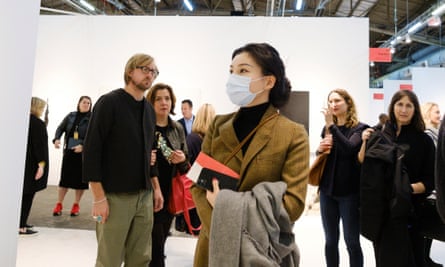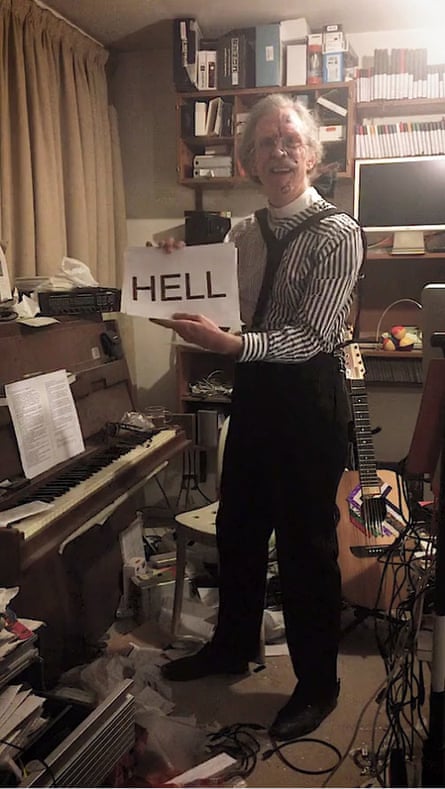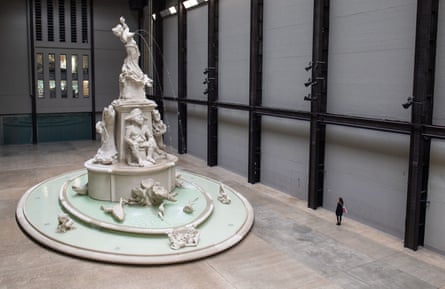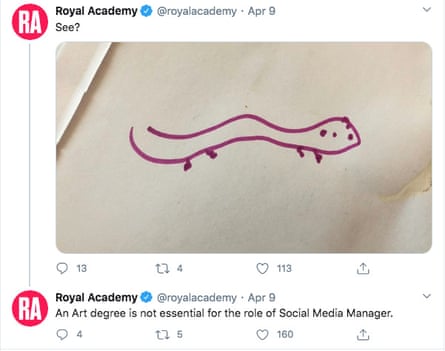Source: The Guardian.
There isn’t a business worldwide that hasn’t felt the virus’s impact, and the art world has been far from immune. The art industry that has become synonymous with hyper-connectedness and global mobility is now at a standstill. The glitzy fairs and crowded shows are history, replaced with Zoom studio tours and virtual exhibitions. Andrew Dickson reflects if this might actually mark an improvement.
In the first week of March, New York’s Armory Show opened on schedule, as it has done for the past 26 years. Despite coronavirus concerns, gallerists and collectors from across the globe packed Piers 90 and 94 on the West Side of Manhattan for one of the ritziest art fairs in the calendar. Big sales were made – a painting by the superstar contemporary painter Kehinde Wiley went for $280,000 (£220,000) – and the organisers congratulated themselves on not surrendering to the fearmongers (“New Yorkers are strong,” concluded the fair’s director, Nicole Berry). Aside from the absence of air-kissing and the prevalence of hand sanitiser, it was hard to spot anything amiss.
Only a month later, the Armory Show looks like the last days of the Roman Empire. Days after it closed, European countries had gone into lockdown. Art fairs elsewhere were being cancelled by the dozen and auctions postponed. By mid-March, galleries worldwide had locked their doors; haemorrhaging income, many started furloughing or laying off staff. New York itself has become the epicentre of the North American outbreak. And Pier 90 is now famous for a grimmer reason: it’s where a US Navy hospital ship is moored.
There isn’t a business worldwide that hasn’t felt the virus’s impact, with calamitous results for millions. And the art world has been far from immune. An industry that has become synonymous with hyper-connectedness and global mobility is now, like the rest of us, at a standstill. The art market is idling. The places where we experience art – from leading museums to the tiniest independent spaces – are abruptly out of bounds. Many galleries are likely to go out of business; artists will lose livelihoods. A recent piece by the New York magazine art critic, Jerry Saltz, carried an apocalyptic headline: The Last Days of the Art World.

The last days before the lockdown … a woman wears a face mask while visiting the Armory Show in New York last month. Photograph: Justin Lane/EPA
But what sort of changes, and what sort of things? Is there only emptiness on the horizon, or are there opportunities, too? And when we finally emerge, what will art – and, yes, the art world – look like?
One glimmer of hope is that, though we can’t see art in person, we seem hungry to access it by any means possible. Galleries have been experiencing record web traffic: visitors to the British Museum site soared in the early days of the crisis, while the Courtauld Gallery’s virtual tour reported an astonishing 723% spike in visitors in mid-March. Every private gallery worth its salt has launched “online viewing rooms”. Even the blue-chip Art Basel Hong Kong fair went virtual after being forced to cancel the physical event.
“It’s unprecedented,” says Alison Cole, editor of industry bible the Art Newspaper. “After talking about it for years, a lot of people are finally seizing the opportunity of online.”

Artist Martin Creed livestreams a jam session from his home. Photograph: http://www.martincreed.com/site
Social media has been part of the art world for a while. But with physical galleries now empty it’s suddenly the sole means for organisations to retain a connection to audiences. The most august institutions are revealing a more unbuttoned, down-to-earth side: the Royal Academy Twitter feed, previously full of earnest promos for RA events, has been taken over by an #RAdailydoodle challenge aimed at amateur artists (sample post: “Who can draw us a thirsty ferret?”). Other galleries are trialling similar projects – less top-down, more collaborative.
Morris at Tate detects a deep shift: “Having a real conversation with real people is hugely exciting. I think it’s partly because people are missing the social space of being in a museum. It’s something we haven’t always done enough. And once we reopen, we get a chance to recalibrate that.”
The same is true behind the scenes, she adds: the fact that the hectic merry-go-round of openings and events has paused means that it’s possible to get hold of people. “Everyone seems more available, perversely. I’ve been having conversations with colleagues from all over the world.”
Beneath all this, of course, there is a grim reality: money. With the global economy stalled, the wealth that has fuelled the art world for the past 20 years – a period of discombobulating growth, museum expansions, soaring auction prices, more art fairs by the month – is suddenly in doubt.
“It feels like we’ve been partying for the last two decades,” says Morris. The commercial gallerist David Zwirner, who now has spaces in New York, Hong Kong, London and Paris, concurs: “It got out of hand, especially the market: crazy auction prices and the rest. The infiltration of value into the perception of art, art being regarded as an asset – all that needs to be rethought.”
Is he fearful for the future? “Of course. There’s going to be a lot of pain, especially for smaller galleries. And, of course, artists.”
Cole is similarly anxious: “At the top end, the art world is a luxury industry, but many of the people who work in it – the artists, the handlers, gallery staff – are in very precarious positions. We published an article the other day saying that a third of French galleries could close by the end of 2020. Even if the art market bounces back, it’s going to be a much smaller world.”
Yet, while accounting for these very real hardships – local museums in the UK are especially vulnerable – both Cole and Morris argue that there are clues here as to how things might operate differently. “‘Normal’ was unsustainable,” Cole argues. “The endless expansion, the mega-collectors, the purchasing of big trophy objects. I think we’re entering a period of less is more. I hope it’ll be less macho.”

A final look at Fons Americanus, Kara Walker’s Turbine Hall commission as the Tate Gallery went into lockdown. Photograph: Dominic Lipinski/PA
Morris suggests that footfall-driving blockbuster exhibitions, with star loans shipped carbon-intensively from Berlin to LA to Tokyo, might have had their day. “It’d be great for museums to focus on their permanent collections, the amazing things we already possess. We’ve taken our eye off the core mission. I’d love a return to slower looking.”
Everyone agrees that, whatever comes next, galleries will have a bigger role than ever. The moment they reopen, it’s hard not to see them being thronged, says Zwirner: “The work of art in a physical space is different: it craves you. Looking at art is a communal act.”
The big question, of course, is what we’ll be looking at: with an event as all-enveloping as the current pandemic, is it too early to speak of “corona art”?
The contemporary artist Ryan Gander has talked of the “time famine” afflicting the art world; artists – like many of us – now have plenty of time on their hands. And whether they’re sequestered in their studios or trying to balance childcare and laundry, many will end up channelling their experiences of this strangest of moments into the work they make. Judging by Gander’s Zoom studio tours and Martin Creed’s livestream jam sessions, some already are.

Sketchy … the Royal Academy’s doodle a ferret challenge. Photograph: RA Twitter – @royalacademy
Morris isn’t sure what will result, but feels confident that it will be worth attending to: “If you look at the great traumatising events of the past – world wars, global emergencies of different kinds – artists have always responded,” she says. “After the first world war it was dada and surrealism; after the second, existentialism and gestural abstraction. Whatever the work looks like, it’ll be interesting.”
Keen to get an artist’s perspective, I track down the Argentinian-born, New York-based Mika Rottenberg, best known for her unsettling installations and videos, some of which take aim – appropriately enough – at the excesses of late capitalism. When we Skype, she’s in upstate New York, trying to balance home-schooling her daughter and connecting with colleagues and friends, many of whose projects have been cancelled or postponed.
Nonetheless, Rottenberg seems – if not exactly upbeat – at least philosophical. As an active member of the Culture Declares climate movement, she sees a strong connection between the climate emergency and the coronavirus one, and she is thinking hard about how art fits in – both as a response and something that can illuminate a path forward. More practically, she is using tools such as video conferencing to collaborate with other artists and scope out projects. She can’t be physically present in a gallery, but perhaps she doesn’t need to be.
“The fear is that we become more conservative, build a wall around ourselves,” Rottenberg says. “I really don’t want that to happen. And even if we can’t travel, I don’t want us to abandon that sense of global connectedness, the exchange of ideas. Right now we need hospital beds and ventilators and masks, but art has a role to play too. It has to.”
Has she actually been able to get any work done? She laughs. “I’m used to multi-tasking. When I’m not editing video, my favourite spot in the studio is the kitchen table.”
Coronavirus has shown how many of us, when trapped at home, have reached instinctively for art. Maybe it’s taking a virtual spin around the Sistine Chapel, or dusting off craft materials. Maybe it’s sketching ferrets.
“People are really having to make do with what they have,” says Cole. “They’re sharing images, video, memes, using art in all sorts of creative ways.” She ponders the question. “Art is really useful at the moment. Whatever comes next, we have to cling to that.”








